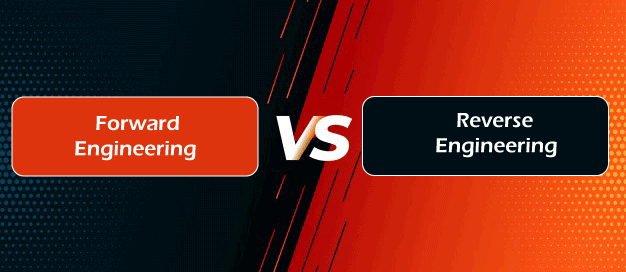Difference Between Forward Engineering and Reverse Engineering

Forward engineering and reverse engineering are two distinct approaches used in the field of engineering and software development. Here are the main differences between them:
-
Purpose:
- Forward Engineering: Forward engineering involves creating a new product, system, or software from scratch based on predefined requirements and specifications. The goal is to progress through the design, implementation, and testing stages to develop a new solution.
- Reverse Engineering: Reverse engineering involves analyzing an existing product, system, or software to understand its design, architecture, functionality, or behavior. The goal is to gain insights into how the existing solution works and potentially recreate or reproduce it in some form.
-
Starting Point:
- Forward Engineering: Forward engineering starts with a set of requirements and specifications for the desired product or system. The development process begins with conceptual or high-level design and progresses through implementation and testing.
- Reverse Engineering: Reverse engineering starts with an existing product, system, or software that may lack proper documentation or whose internal workings are not fully understood. The process involves examining the existing solution to uncover its design, structure, and functionality.
-
Direction of Analysis:
- Forward Engineering: In forward engineering, the analysis and design efforts focus on creating new solutions and developing plans for their implementation. The direction of analysis is forward-looking, starting from requirements and moving towards implementation.
- Reverse Engineering: In reverse engineering, the analysis efforts focus on understanding existing solutions by examining their components, structure, and behavior. The direction of analysis is backward-looking, starting from the existing solution and working towards understanding its underlying principles.
-
Outcome:
- Forward Engineering: The outcome of forward engineering is the creation of a new product, system, or software that meets the specified requirements and objectives. The result is typically a forward progression from design to implementation to deployment.
- Reverse Engineering: The outcome of reverse engineering is gaining insights into an existing product, system, or software, often with the goal of reproducing or modifying it. The result is typically a deeper understanding of the existing solution's design, architecture, and functionality.
-
Applicability:
- Forward Engineering: Forward engineering is commonly used in scenarios where new solutions need to be developed from scratch, such as product development, software engineering, and system design.
- Reverse Engineering: Reverse engineering is commonly used in scenarios where existing solutions need to be analyzed, modified, or reproduced, such as legacy system maintenance, interoperability, security analysis, and competitive analysis.
In summary, forward engineering involves creating new solutions based on predefined requirements, while reverse engineering involves analyzing existing solutions to understand their design and functionality. Both approaches have their distinct purposes and applications in engineering and software development.
Thank you,
